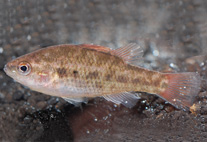Abstract
A new species of pygmy perch (Percichthyidae) from south-western Australia is described on the basis of 15 specimens collected from the Hay River system. Nannoperca pygmaea sp. nov. differs from the sympatric congener N.vittata (Castel-nau) by the absence of dark pigment on the ventral surface anterior to the anus, the possession of thin latero-ventral stripes, generally fewer dorsal rays and fewer anal rays, hind margin of scales on caudal peduncle without distinct pigment, and a more pronounced spot (ocellus) that is surrounded by a halo at the termination of the caudal peduncle. The new species is distinguished from congeners Nannoperca australis Günther, N. oxleyana Whitley and N. variegata Kuiter and Allen in possessing an exposed and serrated preorbital bone and jaws that may just reach to below the anterior margin of the eye, versus a smooth and hidden preorbital and the jaws reaching to at least below the pupil; and from the remaining congener, N. obscura (Klunzinger) in possessing a distinct haloed ocellus at base of caudal fin versus an indistinct barring, as well as a dark spot behind operculum, and the lack of dusky scale margins. It differs from the other sympatric pygmy perch found in the region, N. balstoni Regan, by the presence of an exposed rear edge of the preorbital (vs. hidden under skin), fewer transverse scale rows (13 vs. 15–16), small mouth (rarely reaching eye vs. reaching well beyond eye), ctenoid (vs. cycloid) body scales, generally fewer pectoral rays and smaller maximum size. Allozyme analyses unequivocally demon-strate that sympatric populations of N. pygmaea sp. nov. and N. vittata belong in different genetic lineages, display no genetic intermediates, and are diagnosable by fixed allozyme differences at 15 different loci. Due to its extremely restrict-ed range, where it is known from only 0.06 km2, N. pygmaea sp. nov. requires urgent legislative protection.

